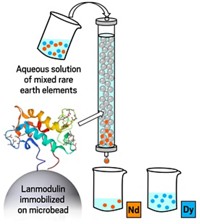Advertisement
Grab your lab coat. Let's get started
Welcome!
Welcome!
Create an account below to get 6 C&EN articles per month, receive newsletters and more - all free.
It seems this is your first time logging in online. Please enter the following information to continue.
As an ACS member you automatically get access to this site. All we need is few more details to create your reading experience.
Not you? Sign in with a different account.
Not you? Sign in with a different account.
ERROR 1
ERROR 1
ERROR 2
ERROR 2
ERROR 2
ERROR 2
ERROR 2
Password and Confirm password must match.
If you have an ACS member number, please enter it here so we can link this account to your membership. (optional)
ERROR 2
ACS values your privacy. By submitting your information, you are gaining access to C&EN and subscribing to our weekly newsletter. We use the information you provide to make your reading experience better, and we will never sell your data to third party members.
Separations
Microbial column captures rare earths from electronic waste
Researchers make hydrogel beads full of bacterial matter that capture rare-earth elements
by XiaoZhi Lim, special to C&EN
December 12, 2019

Rare-earth metals are crucial ingredients in ultrastrong magnets needed for consumer electronics, wind turbines, and electric vehicles, but they are produced in only a few places on Earth, making their supply somewhat vulnerable to geopolitical spats. Recovering these elements from the many tons of electronic waste produced per year could help diversify supply. Now researchers have created gel beads laden with bacteria that can adsorb rare-earth metals, providing a straightforward column separation process for extracting these valuable metals with microbes (Environ. Sci. Technol. 2019, DOI: 10.1021/acs.est.9b04608).
Previously, researchers had engineered bacteria with surface receptors that can pick out rare earths from complex sources like electronic waste. But no matter how well any bacteria can bind metals, it’s hard to use them practically. “The microbes are so small and light,” says study coauthor Yongqin Jiao of Lawrence Livermore National Laboratory (LLNL). In microbial separation processes, typically the bacteria must first soak in a solution containing a mixture of metal ions, such as a leachate from electronic waste. But after that, it is difficult to remove the microbes from the mixture, she says.
To address this problem, Jiao and her colleagues incorporated microbes into a column chromatography process that sorbs rare earths from a feedstock solution and then releases them when the right solvent flows through the column. She and her LLNL colleague Dan M. Park first trapped bacteria in hydrogel beads. The researchers used an Escherichia coli strain that they had previously engineered to produce peptides that bind preferentially to rare-earth elements. The bacteria display the peptides on their surfaces, Park explains. The researchers then added hydrogel precursors and a light-responsive polymerization initiator to a suspension of the bacteria, shook the watery microbial mixture with oil to create droplets, and shined ultraviolet light on it to trigger polymerization of the hydrogel. The liquid droplets instantly solidified into beads roughly 60 µm in diameter, which the researchers dried and packed into a 77 mL glass column. The microbes die during the polymerization, but their peptide-laden surfaces are still accessible within the beads.
The researchers pumped a feedstock sent from colleagues at Idaho National Laboratory—who prepared it by bathing spent mobile phone speaker components in sulfuric acid—through the column. Rare earths such as neodymium, praseodymium, and dysprosium ions bound to the microbial beads, while other elements like iron and cobalt passed through. Flushing the beads with a citrate solution, a common eluent in rare-earth extraction, released the elements. The column retained 85% of its adsorption capacity after nine reuses.
Because the cells are dead, “our process is not driven by any microbial metabolism,” Jiao says. The researchers don’t have to worry about feeding the cells, keeping them at the right temperature and pH, or preventing their exposure to toxic materials.
“The results are promising, but it definitely needs to be tested at a larger scale,” says Emma J. Gagen, an environmental microbiologist at the University of Queensland. At an industrial scale, the microbial column will have to cope with a lot more variability in the feedstock, she says.
The researchers are now testing different eluents to wash individual rare-earth elements off of the column one at a time. They are also working to boost the adsorption capacity of each bead by increasing the amount of cell matter within. So far, they’ve managed to raise capacity eight to ten times higher than what is reported in the study. Eventually they hope to test a large column containing 10– 15 L of beads.
Gagen thinks metal extraction could be more sustainable in the future if the entire process becomes microbial, by first using well-known acid-generating bacteria to dissolve metal ions from electronic waste before running the resulting feedstock through the microbial column. “That would be pretty exciting,” she says.




Join the conversation
Contact the reporter
Submit a Letter to the Editor for publication
Engage with us on Twitter